Tools - Southern Europe - Fotogalerie - Sold antiquities
Archive of sold antiquities
All artefacts sold in our gallery are fully documented in our online archive and database. Being a specialist ancient art dealer, preserving also the more recent history of each and every piece sold in our shop is at our heart. That is particularly useful for artefacts that changed owners in the meantime. Information that may have been lost in the process can be easily restored from our archives. Please do not hesitate to contact us if you need further information about ancient items that have been sold in our gallery. We can help you with reconstructing the history of ownership for those items. All information about our customers will be kept confidential, of course.-
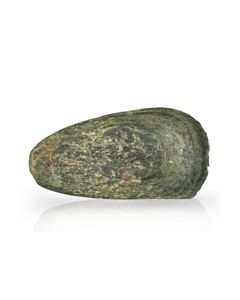 Neolithic axe head
Neolithic axe headNicely crafted Stone Age tool made of jadeite. From southern France.
Price: on request Neolithic axe head
Neolithic axe headNicely crafted Stone Age tool made of jadeite. From southern France.
Price: on request Neolithic axe head
Neolithic axe headNicely crafted Stone Age tool made of jadeite. From southern France.
Price: on request Neolithic axe head
Neolithic axe headNicely crafted Stone Age tool made of jadeite. From southern France.
Price: on request Neolithic axe head
Neolithic axe headNicely crafted Stone Age tool made of wonderful light green jadeite. From southern France.
Price: on request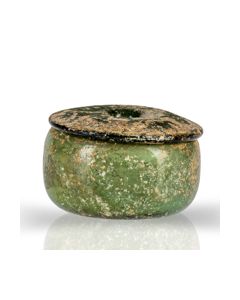 Roman glass inkwell
Roman glass inkwellLow vessel of cylindrical shape. The stylus was dipped into the ancient inkwell and wiped off at the edge. Beautiful, rich green glass.
Price: on request Neolithic axe head
Neolithic axe headNicely crafted Stone Age tool made of jadeite. From southern France.
Price: on request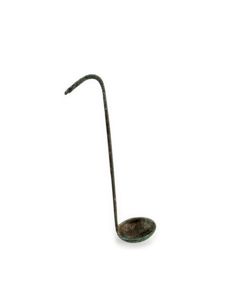 Ancient ladle with donkey head terminal
Ancient ladle with donkey head terminalElegant long bronze ladle, from the Greek or Etruscan culture. 5th to 4th century BC.
Price: on request Ancient ladle with bird head terminal
Ancient ladle with bird head terminalElegant long bronze ladle, from the Greek or Etruscan culture. 5th to 4th century BC.
Price: on request Late Roman votive mirror
Late Roman votive mirrorExceedingly rare in this state of preservation, including remains of the original glass and reflective lead foil.
Price: on request Roman bronze lock bar shaped as herm
Roman bronze lock bar shaped as hermMassive piece with great patina. From a German private collection, acquired in the early 1980s.
Price: on request Roman bronze lock bar
Roman bronze lock barMassive piece shaped as a herm, with great patina. From a German private collection, acquired in the early 1980s.
Price: on request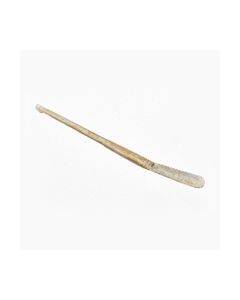 Roman strigilis with workshop mark
Roman strigilis with workshop markExcellently preserved, massive bronze, stable. Workshop mark "N" on the reverse.
Price: on request
 Roman bronze strainer from "Museum fuer Morgenlandfahrer"
Roman bronze strainer from "Museum fuer Morgenlandfahrer"Large piece in very good condition with nice patina. On display in "Ex Oriente Lux" exhibition, published in the corresponding catalogue.
Price: on request Roman scale balance with pans
Roman scale balance with pansWell preserved small bronze scale. Including two dished pans decorated with incised concentric rings.
Price: on request Roman specillum
Roman specillumThe so-called specillum is a surgical probe. It was standard issue for roman doctors. Similar probes are still in use today. 1st to 4th cent. AD.
Price: on request Roman surgical probe made of bronze
Roman surgical probe made of bronzeThe so-called specillum was standard issue for roman doctors. Similar probes are still in use today. Very fine craftsmanship of an ancient surgical instrument.
Price: on request Roman surgical probe made of silver
Roman surgical probe made of silverThe so-called specillum was standard issue for roman doctors. Similar probes are still in use today. Ancient surgical instruments made of silver are extremely rare.
Price: on request Römischer Bronzeschlüssel
Römischer BronzeschlüsselBart vollständig erhalten mit schöner Patina, ungewöhnliche Form mit sehr kurzem flachem Griff und daran ansetzendem, großem Ring.
Price: on request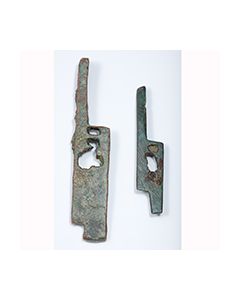 2 römische Schlossriegel
2 römische SchlossriegelAntike Bolzen für ein Schloss einer Tür oder Truhe. Bronze, 1. bis 4. Jh.n.Chr.
Price: on request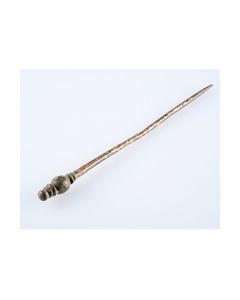 römischer Stilus aus Bronze
römischer Stilus aus BronzeSpitzer Stift aus Bronze zum Beschreiben von Wachstafeln. Mehr als 12cm lang, sehr gute Erhaltung. Aus alter deutscher Sammlung.
Price: on request römischer Luxusstilus aus Messing mit Beingriff
römischer Luxusstilus aus Messing mit BeingriffSpitzer Stift aus Messing zum Beschreiben von Wachstafeln. Beingriff mit Messingtülle, sehr gute Erhaltung.
Price: on request Kleiner Axtkopf
Kleiner AxtkopfNeolithisches kleines Beil. Sehr schöne polierte Oberfläche und feine Bearbeitung. 42mm x 33mm x 12mm. Fundort: Osteuropa.
Price: on request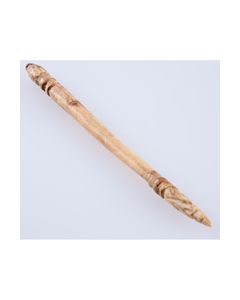 römischer Luxusstilus aus Bein
römischer Luxusstilus aus BeinSpitzer Stift aus Bein zum Beschreiben von Wachstafeln, verziert, sehr gute Erhaltung.
Price: on request Gruppe von 2 Spinnwirteln aus Stein
Gruppe von 2 Spinnwirteln aus SteinHellenistische bis römische Zeit, Fund von der Levante, östlicher Mittelmeerraum. Beide Wirtel in musealem Zustand.
Price: on request Gruppe von 2 Spinnwirteln aus Stein
Gruppe von 2 Spinnwirteln aus SteinHellenistische bis römische Zeit, Fund von der Levante, östlicher Mittelmeerraum. Beide Wirtel in musealem Zustand.
Price: on request Römischer Spinnwirtel aus Stein
Römischer Spinnwirtel aus SteinAntiker Spinnwirtel für Handspindel, aus dunklem Naturstein. 1. bis 3. Jh. n. Chr., schöne Erhaltung.
Price: on request Gruppe von 3 Spinnwirteln aus Stein
Gruppe von 3 Spinnwirteln aus SteinHellenistische bis römische Zeit, Levante. Ein Wirtel mit konzentrischem Liniendekor aus aneinandergereihten Punkten nach fossilem Vorbild.
Price: on request Bronzezeitliche Knopfsichel
Bronzezeitliche KnopfsichelMuseale Erhaltung, satte grüne Patina. Klingenstärke ca. 30 mm, Datierung: 2000 - 1800 v. Chr.
Price: on request Römischer Schlossriegel
Römischer SchlossriegelAntiker Bolzen für das Schloss einer Tür oder Truhe. Bronze, 1. bis 4. Jh.n.Chr.
Price: on request Feuerstein (Klinge oder Feuerschläger)
Feuerstein (Klinge oder Feuerschläger)Spätrömische bis frühmittelalterliche Epoche, aus Fundgruppe zusammen mit Art.Nr. AR1150W061 und anderen.
Price: on request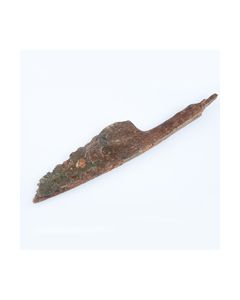 Große römische Messerklinge
Große römische MesserklingeHervorragend erhaltene Klinge eines römischen Messers aus Eisen, 190mm lang. Das Objekt stammt aus einem Grabfund.
Price: on request Römische Pinzette aus Bronze
Römische Pinzette aus BronzeTypische Pinzette der späten Kaiserzeit, nicht restauriert und perfekt erhalten. Schöne, dunkle Patina.
Price: on request Fragment einer Messerklinge
Fragment einer MesserklingeFragment eines antiken Messers aus römischer Zeit. 12cm lang.
Price: on request Römischer Schlossriegel
Römischer SchlossriegelAntiker Bolzen für das Schloss einer Tür oder Truhe. Bronze, 1. bis 4. Jh.n.Chr.
Price: on request

